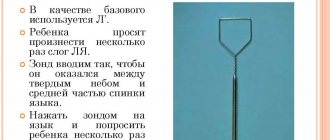Lambdacism
Speech therapists call the inability to pronounce the sounds “L” and “L” correctly the term lambdacism. This means that the sound is not only mispronounced, but is also missed. This could be a congenital speech defect or simply incorrect pronunciation. Lambdacism, in turn, is divided into several types:
- Bilabial. In this version, the child replaces “l” with the sound “u”. For example, he says “horse” instead of “horse”. The lips are involved in pronunciation, the tip of the tongue is lowered, resting at the bottom of the oral cavity.
- Nasal. In this case, instead of “l”, “ng” is pronounced. For example, instead of “forest” you get “nges”. The root of the tongue touches the soft palate, and air is directed into the nose, which helps replace sound.
- Interdental. During pronunciation, the tip of the tongue goes into the space between the teeth.
- No sound is produced at all. For example, instead of “spoon,” “ozhka” comes out.
Paralambdacism
This term refers to the replacement of the correct “l” sound with another. For example:
- “g” – pronounced “kogeno” instead of “knee”
- “v” – pronounced “stov” instead of “table”
- “e” – pronounced “yokot” instead of “elbow”
- “l” – pronounced “lyozhka” instead of “spoon”
All these flaws in pronunciation can be treated by regularly doing exercises with a speech therapist and at home. Specialists are often expensive, but there are cases when just one lesson with a doctor on speech production gives a positive result, and consolidation can already be done at home.
When to contact a speech therapist?
A speech therapist is a qualified specialist who deals with speech problems in children of different ages. Such a teacher is well versed in the developmental problems of children, finds the causes of violations and eliminates defects in various ways. However, many parents wonder when to contact a teacher in order to achieve positive results. Some send their children to a speech therapist as early as three years old, while others begin classes only at 6-7 years old. You should contact a specialist if you identify the following problems:
- the child has organic disorders of the speech apparatus;
- problems with the central and peripheral nervous system that affect the baby’s development;
- the child has mental illness;
- the child is not assiduous and does not want to repeat exercises and pronounce sounds;
- parents become aggressive when the child makes any mistakes;
- contact between the child and mother disappears, the baby is distracted by foreign objects;
- the adult himself pronounces sounds unclearly or teaches the child incorrectly.
You can conduct speech therapy classes at home, but only if the baby is comfortable at this time and he repeats the exercises voluntarily. And if parents start to break down and swear, then don’t expect anything good from such lessons. In any case, high-quality classes will be conducted only by an experienced, qualified speech therapist who is well versed in the psychology of children and preschoolers. It will help you make the “l” sound in the shortest possible time. It is impossible to talk about the exact time, since each child has a different body and character, some learn in a month, while others have to study for six months. It is important for parents to remember that each child requires an individual attitude. Take into account his personality traits, make activities fun and don’t demand more from your baby than he can. Better yet, hire a speech therapist.
Reasons for incorrect pronunciation of “L”
There are no unexplained causes of speech impediment. Doctors identify only three main conditions under which children cannot pronounce “l” correctly:
1. In speech, the child does not perceive “L” phonemically.
Phonemic hearing is what allows a person to distinguish one speech sound from another, hear words correctly and understand them well. Doctors recommend developing this hearing in babies from birth. That is, you need to talk to children without distorting words, so that they hear what will later be used in everyday speech. It must be remembered that written language is also formed on the basis of oral speech. Phonetic awareness thus influences future reading and writing skills. Normally, by the age of 4, a child should confidently distinguish one sound from another and not confuse “night” with “daughter” and “bear” with “mouse.”
2. The second reason for the incorrect pronunciation of “l” is the short hypoglossal ligament, due to the anatomical structure.
3. The inability to say “l” can also be a consequence of weak muscle tissues of the tongue.
We should not forget that for two- to three-year-old children, errors in speech starting with “l” are considered the norm. The formation of the correct pronunciation of “L” refers to older ages - 4 and even 6 years.
Articulation gymnastics
Exercises that increase the mobility of the tongue and lips will help you quickly learn how to correctly pronounce various sounds, and this applies not only to one letter “L”.
L sound articulation profile
Today, researchers have proven that fine motor skills of the hands are directly related to speech, so modeling, finger games, and small toys for a baby are necessary to learn to speak correctly.
The development of hand motor skills helps develop speech.
If, after many efforts, the child still cannot pronounce the letter “L” correctly, it is necessary to contact a speech therapist. Perhaps it is a malocclusion, a neurological disease, or stress. It is important to remember that the age from 4 to 6 years is the most favorable for learning correct speech; later it will be necessary to eliminate the ingrained skill, and this is more difficult to do.
Similar materials
Correct articulation of "l"
When pronouncing any sound, certain organs work. The totality of their actions necessary for the speech apparatus to make a certain sound is called articulation. What organs are involved in the correct pronunciation of the sound “l”? These are lips, teeth, and tongue. All important articulatory instruments are involved. When pronouncing “l” correctly, the following happens:
- The lips occupy the position dictated by subsequent consonants and vowels
- The tip of the tongue rests on the upper incisors or their gums
- The edges of the palate, lips and the entire oral cavity are not connected to the upper incisors, so there are passages for exhaled air on the sides
- the root of the tongue rises when pronouncing the hard “L”
- the soft palate is also raised, blocking the passage into the nasal cavity
- The vocal cords should be closed and their vibration can be felt
If all these conditions are met, the correct pronunciation of the hard sound “l” is obtained. For soft, there are a number of conditions:
- It is not the root of the tongue that is raised, but the anteromedial part of its back
- There is a closure of not only the tip of the tongue with the gums, but also most of the back of the tongue with the alveoli
- Often a soft “l” is produced if the tip of the tongue is lowered and the front part of the back closes with the alveoli
Some speech defects can be corrected by imitation. That is, by teaching the child to repeat sounds, syllables and words by ear. As experts note, in the case of the “l” sound, using only this method will not work. Precisely because of the complex articulatory work of organs. You will have to work on setting them up point by point. Especially if difficulties arise due to weak muscle tissue of the tongue.
Mistakes when trying to pronounce "l"
Among the errors when pronouncing “l” there are the most common ones. They occur in both children and adults, but it is best to correct them at a young age, when the speech apparatus is just subject to adjustment. The most popular mistakes:
- Instead of “l” it sounds “y”. For example, the word “lie down” will be pronounced “yoozhsya”. This happens because the tongue is pulled too far into the depths of the oral cavity.
- Instead of “l”, a combination of “uva” sounds is pronounced. So, “took” will turn into “took”. The lips are placed incorrectly here.
- Replacing “l” with the sound “r”. For example, “medicine” instead of “medicine”.
- Instead of “l”, a sound similar to “f” or “n” is heard. This occurs due to a sharp, forced exhalation and participation in the articulation of the cheeks or nose.
Preliminary articulation exercises
Before moving directly to exercises for making the sound “l”, experts advise doing a series of articulation tasks, the so-called articulatory gymnastics, which precedes the approach to making the sound “l”. This is a kind of tuning of the speech apparatus to master the rebellious sound. Here we work on the movements of the lips and tongue.
To begin with, the child is told and shown the structure of the mouth: lips, upper and lower; behind them are the teeth, upper and lower; at the top - a tubercle; behind it is the hard palate, it continues with the soft palate and ends with the velum palatine, on which there is a uvula. If a child is diagnosed with lambdacism in any form, then first you need to do the following articulation exercises (perform every day in front of the mirror, counting from one to five, for five to ten minutes, twice a day):
- “Smile” - part your lips into a smile, exposing your upper and lower teeth.
- “Tube” - lips are closed and extended forward.
- “Tongue punishment” - the tongue remains on the lower lip, it is spanked, saying “Pa-pa-pa.”
- “Cleaning the upper teeth” (from the inside) - the tongue is made wide, it is moved from side to side at the upper tubercles, also known as alveoli.
- “Sail” - the tip of the tongue should be rested on the row of upper front teeth. The tongue is like a hammock that has sagged. There is no need to move the tongue, it is simply held in this position while counting. The longer you can hold on, the better.
- “The cat drinks milk” - a wide tongue licks the upper lip from top to bottom.
- “Turkey chatter” is the same as in the “cat” exercise, but the movements are fast and accompanied by the sounds “bl-bl-bl-...”.
- “Swing” - with your mouth slightly open, you need to smile widely. On the count of “1-2”, the tip of the tongue rests on the upper and then on the lower incisors (from their inner side).
- “Horse” - click the wide tip of the tongue on the palate behind the upper front incisors. The mouth is open, but the lower jaw does not move at all.
- “Fungus” - the tongue seems to be glued to the palate, the hyoid frenulum is tense.
It is recommended to carry out such gymnastics for two to four weeks. In this way, the skill is developed to fix the necessary articulatory posture, accurately make all movements and monitor the lips, tongue and the entire speech apparatus.
Speech therapy exercises for the sound “L”
After mastering articulatory gymnastics, you can proceed directly to producing the sound “l”. The following exercises are used:
1. Imitation method: the student is shown how to correctly articulate the sound “l”. Smile, open your mouth slightly, open your teeth so that you can place your finger between the upper and lower teeth. The wide tip of the tongue rises and presses against the tubercles, when exhaling, the air flows along the sides, the cheeks vibrate. The child pronounces “l” after the adult. The sound should be produced when the tongue is torn away from the tubercles.
2. Setting from interdental sound (this method is not used if the defect is due to interdental lambdacism). An adult tells a fairy tale “About a steamboat that learned to whistle.”
“Once upon a time, a very tiny one sailed along the sea along with large steamships. He did everything the same as adults, but no one paid attention to him. All because he did not know how to speak - to make a steamship whistle. Instead of the beautiful “L”, he made some incomprehensible and very timid sounds. One day the steamboat decided to learn how to talk and hum like a big one. He learned by saying: “U!O! Everything is wrong." Nobody answered him and there was no dial tone. The steamboat was so upset that he bit his tongue and said: “Y.” Then an amazing thing happened: a clear and clear “L” flashed over the sea. The steamboat said it. He thought, “It must have seemed like it,” and tried again. He bit his tongue again and said: “Y.” It turned out to be a beautiful “L”. And suddenly large steamships began to answer him from all sides: “L!” "L!" So all the big ships learned about the tiny steamer, and it became heard throughout the whole sea.”
After listening to this fairy tale, the child performs all the actions behind the steamboat. He, like a fairy-tale character, may not immediately, but he should get the sound “L”. After this has happened, it must be combined with vowels. It is allowed in the reverse order IL, YL, OL, etc.
3. Method for bilabial lambdacism.
The main thing in this exercise is to learn to subjugate unruly lips. Often they are to blame for poor pronunciation - they stretch out into a tube, wrap themselves up and produce the sound “v” at the output. Speech therapists associate the inability to position the lips correctly with a long period of weaning from the pacifier. The “Smile” and “Fence” exercises are recommended: the lips are specially stretched as much as possible in a smile, the front teeth are exposed and clenched. This position must be fixed and maintained for as long as possible. At first you can’t do this without the help of an adult - you need to hold your lips, parting them into a smile.
4. Setting “L” from soft “L”
At first, learning is possible by pronouncing a soft sound instead of the correct “L”. Then it should be “tidied up” by teaching the child to pronounce the syllables LO, LU, LY, LA, touching the upper lip with the end of the tongue. And gradually removing it behind the upper teeth. It is recommended to massage the muscles around the mouth and lightly spank them with your fingers.
Three exercises to relax your muscles:
- “The horse snorts” - blow hard on your lips, imitating a horse.
- “Fish” - slap your lips together, imitating a fish.
- “Tired” - blow hard on parted lips.
The process of working on sound [L]
If the pronunciation of several phonemes is defective, as well as if speech disorders occur in adulthood after suffering stress or injury, it is necessary to seek qualified help from a speech therapist. If an adult pronounces only one or two phonemes incorrectly, he can cope with the speech problem on his own at home, without the help of a specialist.
The process of eliminating defective pronunciation of any sound consists of four stages: preparatory, production itself, automation, differentiation.
You cannot skip a stage and move on to the next one without completely mastering the previous one.
Preparatory exercises for sound [L]
The preparatory stage serves to create the correct articulatory position. It involves performing special speech therapy exercises. To correctly reproduce the sound [L], it is important to raise the tip and back of the tongue, learn to relax the lateral edges and make a targeted exhalation.
To practice lifting the tip of the tongue, the following exercises are used:
- Open your mouth, lips are not tense, a relaxed tongue is quickly placed first on the upper lip, then on the lower. Gradually complicate the action by moving the tongue into the mouth, fixing it at the alveolar processes.
- Open your mouth. Using a flat tongue, lick the relaxed upper lip, moving from top to bottom, then hide the tongue towards the middle of the palate.
- Smile and open your mouth. Press your flat tongue against the upper alveoli and loudly tear away. Start slowly, gradually accelerating.
- Smile with your mouth open. Use the flattened edge of your tongue to slap your upper lip back and forth, trying not to separate your tongue from your lip. Start performing actions slowly, gradually pick up speed and connect the vocal cords, achieving the combination [Bl-bl].
- Tighten the bent tip of your tongue and move it back and forth across the palate at different speeds. The interdental space is equal to the thickness of a finger. The lips open slightly and do not touch the incisors. The jaws are static.
Raising the back of the lingual back is practiced by singing the vowel phonemes [O], [U], [A], [Y]. To train the skill of lowering the sides of the tongue and purposefully exhaling a stream through the gap between them and the molars, you need to tightly hold the flat tip of the tongue with your teeth, exhale air, puffing out your cheeks, and at the same time lightly tap them with your fingers to make a squelching sound.
When the articulatory organs are ready and the exercises can be performed flawlessly, at a fairly rhythmic pace, you can start setting up the sound.
Methods for producing the sound [L] in adults
The production of the [L] sound in adults is carried out using the same methods as in children; the choice of technique depends on the mechanism of the defect.
Staging sound in the event of its absence is possible in three ways:
- From the reference phoneme [A]. Place the flat edge of the tongue on the lower lip and lightly press it with the incisors. The tongue is motionless. Do it multiple times. Then you need to extend the sound [A] at the moment of biting your tongue, gradually increasing the speed. The syllables AL and LA should be heard. After receiving the necessary syllables, move the tongue behind the teeth to the correct position for articulation [L].
- Mechanically from the reference phoneme [U]. Place your tongue between your outstretched lips. Stretch [U], at the same time separate the lips with your fingers, moving them towards the front wall of the incisors.
- From the reference phoneme [ы]. The production is performed in the same way as from the phoneme [A].
Similar methods of setting [L] are used for interdental [L] and when replacing it with phonemes [Y] and [G]:
- With nasal lambdacism, it is necessary to achieve precise movement of the air flow: the air should be exhaled through the mouth.
- When replacing [L] with the phoneme [Y], one must learn to hold the tip of the tongue, pressing it firmly against the upper incisors, and relax the middle of the lingual back, lifting the root. In order for the tongue to take this position, you need to place the flat tip on the lower incisors and stretch [Y] or place a round object in the middle of the tongue, lifting the tip of the tongue to the upper alveolar process.
- When replacing with [U], you should achieve a static state of the lips.
- If there is a replacement for [B], the activity of the lower lip must be eliminated. To do this, you must first learn to lower it, opening the incisors, and hold it in this position, then raise the tongue to the upper molars. Do it repeatedly. If you can’t do it correctly, you can place a tense finger under your lower lip and help them.
The performance is completed when the person can pronounce the sound in isolation.
Automation and differentiation of sound [L]
Correct pronunciation of a sound requires mandatory automation, that is, consolidation in spontaneous speech. It should begin with pronouncing forward and backward syllables. At first, you need to speak the syllables slowly, drawing out each sound. This helps the speech organs take the correct position. The speed of pronouncing syllables gradually increases, approaching the usual rate of speech. After successfully pronouncing a sound in syllables, you can automate it in words and then in sentences. Automation is positively influenced by memorizing poems rich in fixed sound, retelling and composing texts.
The final step in working on sound pronunciation is the stage of differentiation. This is the discrimination of phonemes that are similar in articulation and sound. At this stage, a person learns not to replace them in speech and not to confuse letters in writing. This is most important for those who have previously experienced paralambdacity.
Differentiation, by analogy with automation, begins with the distinction of phonemes in syllables, then proceeds to words and phrases. When differentiating, it is important to use tongue twisters. After the final stage, children freely use the correct sound in their own speech. But an adult may take much longer due to too much mispronunciation.
Thus, you can learn to correctly speak the sound [L] to an adult on your own in the absence of other speech problems. The difficulty is that self-control will be required for quite a long time. It is needed in order to eliminate the existing automatic skill of incorrect pronunciation.
Automation of the sound "L"
To fix the sound after at least a month of work, you need to use the following methods:
- Pronounce soft syllables and words. For example: “Lyu: cradle, people, love.”
- Learn and speak simple phrases. “LE-LE-LE – leaves were lying on the ground” and others. You can compose them yourself.
- Come up with and repeat funny poems and tongue twisters starting with “L”.
- When a sound is produced in direct syllables, you need to fix it in reverse ones. OL, EUL, etc.
Be sure to control the position of your tongue in the mirror. And do not overload the texts with words with the letter “R”. The child must focus on one complex sound.
Automation of the hard “L” occurs by analogy. First, the child repeats after the adult, then does the exercises himself.
The exercises suggested above can be done independently at home. But if there is no improvement, you should definitely go to a speech therapist.
Speech correction
Sometimes the production of the sound li is complicated by the fact that the child pronounces the wrong sound, and then begins to insert “L” in all words, even where it should not be there. Therefore, it is easier for those children who do not pronounce sounds at all in place of “l”. In order to teach a child soft l and hard l, you need to imitate the correct sound. At the same time, parents must show how the articulatory organs should be located. For the exercise, it is better to use a mirror so that the child compares the articulation of the speech therapist and his own. Such a device will give good efficiency. The baby’s tongue should be positioned the same way as in the “Hammock” exercise: the tongue is extended, the tip is pressed against the front teeth. The middle area of the tongue is bent downwards, and the root is elevated. The side of the tongue should remain motionless. The air should be directed to the cheeks, where a slight vibration appears.
But not all children, especially young children, can perform such an exercise. Therefore, you can use simpler methods of staging and automating the sound of l. You can read a short summary or story, during which you can playfully practice the desired sound. Let the child repeat after you the sound of a steam locomotive, and so on. You can ask your baby to repeat the words and syllables you spoke. This is how speech also develops.
As soon as you see the results, you need to work on producing the sound l from the soft l, because often children pronounce only a soft sound, and the hard one is more difficult. Therefore, classes are held in stages and include different exercises and techniques. As soon as the sounds begin to work out, you can move on to syllables: la, lo, li, ly and so on. You can also use the reverse order: al, ol, st, yl.
Exercises for making the sound l can be done at home, but they will not be entirely effective. It is important for parents to approach things correctly and conduct lessons in a playful way. The child should not lose the desire to exercise and curl. Scolding and forcing students to learn something is strictly prohibited. If you decide to practice at home, then start with a few minutes. 2-5 minutes for the first time will be a good result. Then you can extend the classes to half an hour. You shouldn’t do any more, otherwise the child will get very tired.
Soft "l"
Children begin to pronounce the sound “l”, but may miss it in words. In such situations, you need to start training with a soft “l”. It is important to pronounce both the sound and the syllables involving l. As soon as they start to work out, you can move on to words. The order is something like this: la-lily of the valley, li-lemon, le-petal. There are other ways to make the sound l - this is the repetition of tongue twisters. Lessons should be conducted after oral gymnastics. Examples are given below.
- Lyuba loves buttercups.
- Lily of the valley grew up in the forest.
- Clara loves Karl.
- Karl stole corals from Clara, and stole Clara and Karl's clarinet.
As soon as you start to get a soft sound, you need to move on to automation. Let the child clearly pronounce words with “l” and come up with sentences. The more he talks and tries, the sooner the sound will be played.
Hard "L"
The soft sound is much easier to pronounce than the hard “l”. You'll have to tinker with it for weeks. The training methods are almost the same, but the number of repetitions will have to be increased. Say with your child: la, lo, lu, ly, le. Next you need to pronounce the words: moon, bow, magnifying glass, treasure, sorcerer. Tongue twisters can also be repeated. Important note: when teaching hard or soft "l", do not use words that have the letter "r" in them. Otherwise, the child will get confused, be distracted by another sound and begin to have trouble remembering what was said.










